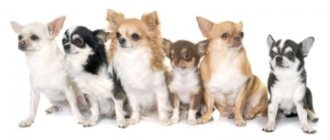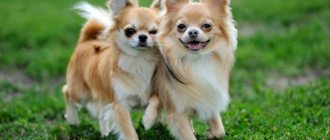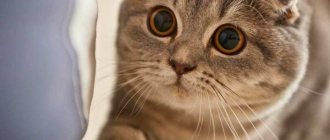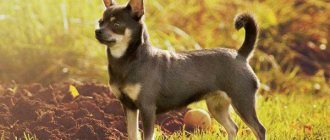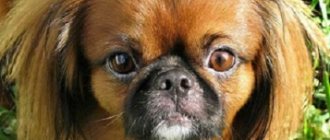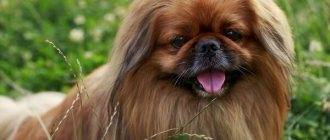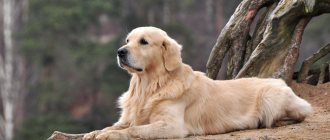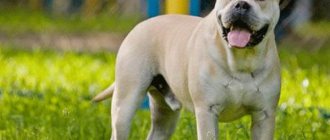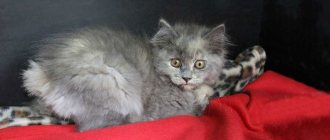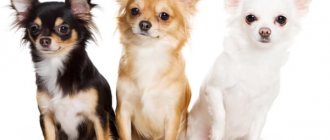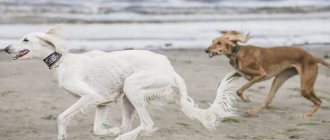The Chihuahua is a small, beautiful dog that is very popular today.
When purchasing such a dog, you need to keep in mind that there will be no less worries with him than with a large dog.
The breed is not suitable for everyone.
Therefore, it is important to be informed so that you do not have to be disappointed in the dog, because everyone dreams of finding a pet exactly to their liking.
Let's find out about everything in detail.
Origin of the Chihuahua Pocket Dog
According to the hypothesis of historians, the Chihuahua breed originates in the Mexican state of Chihuahua. The priests of the Aztec tribes considered them sacred and kept them close to them for protection from evil spirits. They called the dogs Techichi. Even after death, the owner and pet were buried together, so that the dog would remain a guard in the afterlife.
In the sixteenth century, the breed was exterminated by the Spanish conquistadors, who seized the lands of the Indians and Aztecs. They ate dogs and used them to catch rats on ships. Although there is a version that the Chihuahua is a mixture of the Chinese Crested and Techichi.
Three hundred years later, the Americans restored the breed, and since the twentieth century, it has spread throughout the world.
In 1904, an entry was made into the US stud book, in 1923 the first club of mini-dog owners was created, and by the mid-twentieth century, 24,000 individuals were registered.
Mexican Chihuahuas came to Russia in 1959. Fidel Castro brought Mishter and Mushinka as a gift to Nikita Khrushchev. Later, a bitch named Doll was brought from Europe, from which the history of the breed in Russia began.
Attitude towards children and animals
Each individual is individual, but most Chihuahuas love children. It is important to understand that communication between a child and a dog can lead to unpleasant consequences. The animal can be injured from the rash actions of the baby. The dog, in turn, will not tolerate cruelty and may bite a child in self-defense.
Children under 5 years of age must interact with the pet under the close supervision of their parents; being alone is unacceptable! With children over 5 years of age, parents are required to provide strict instructions on how to handle animals.
I do not recommend getting a Chihuahua if there are small children in the family, up to 5 years of age inclusive. I advise you to take a closer look at large and pliable breeds, or even refrain from acquiring four-legged friends.
Chihuahuas prefer to communicate with their own individuals, but also get along with other animals. There are many cases where animals grew up together and became good friends. For example, a friend of mine grew up with a chihuahua and a ferret. Now you can't spill them with water. Birds, hamsters, rats and guinea pigs should be kept away from the dog.
An adult will be less happy about the new family pet. It is possible to display aggression, develop a spirit of competition, jealousy, and enmity. But here it largely depends on the Chihuahua’s temperament and the degree of socialization.
Features of this breed
The main feature of the breed is its miniature size. Thanks to the size of the tiny ones, it is easy to travel - Chihuahuas can be taken with you to shops, restaurants, or transported not in the luggage compartment, but in the cabin of the plane. They tolerate travel and flights well and are considered excellent companions for their owners.
They are unpretentious to living conditions, content with walks on the balcony, the main thing is that their beloved owner is nearby. By nature they are jealous, reckless and touchy, they like to feel in first place.
Marriage or breed?
Since all colors, except merle, are currently standard for Chihuahuas, a pure black color cannot be regarded as a defect in the breed.
Expert opinion
Kozhevin Semyon Kirillovich
Expert dog handler.
Black color is considered one of the main ones. Black Chihuahuas can be carriers of any other gene and such dogs are convenient for breeding. But you need to remember that a black Chihuahua, which is a carrier of chocolate or red color, may have a brownish tint to its coat, and in some cases even look dark brown. Such a dog, in addition, may have an undercoat of a different color - grayish or light fawn, which is especially noticeable in long-haired dogs.
What types of Chihuahuas are there?
Depending on the criteria considered, there are several types of Chihuahuas. The following sizes of pocket pawls are acceptable:
- micro - weight no more than 1 kg, they often get sick because they are considered the result of a selection error;
- mini – up to 1.5 kg, prone to injury;
- standard - the largest (from 1.5 to 3 kg), have good health.
Depending on the body shape of the Chihuahua, there are two types:
- cobby – short legs, large head, well-developed muscles;
- dir – “deer” type, refined and refined with a narrow muzzle and undeveloped muscles.
Based on their appearance and coat type, dogs are divided into four groups:
- short-haired - Chihuahuas with medium length hair, not recognized by the standard;
- long-haired - a distinctive feature is feathering on the paws, ears, tail, neck;
- smooth-haired - Chihuahua with a tight-fitting, hard coat;
- hairless - velvety, without hair, with an attractive skin color.
Education and training
A common mistake made by new dog breeders is that small dogs do not need to be trained. Remember, every pet needs education and training, even miniature ones. First, you need to teach your dog to defecate in a litter box or outside (depending on where you live with him).
When you notice that she is sniffing the floor in search of the toilet, take her to the appropriate place. After she has emptied, praise and pet her. Strengthen the positive reinforcement with something tasty and treat your pet.
Any training must start with the basics. Your animal must know its name. Since Chihuahuas are smart dogs, they quickly remember what you named them. Repeat your pet's name in his presence, especially when you want to attract his attention.
Do not allow him to torment household toys, so that he does not perceive domestic aggression, even humorous, as the norm. Also condemn his attempts to bite you or one of the guests. Train the animal. Invite him to keep his distance from people entering the house. This will allow you to train patience and endurance. When it has completely calmed down, allow it to approach the person to sniff it.
No corporal punishment! Only verbal reprimand. Use this as a last resort. Never ignore your dog's aggression on the street. Under no circumstances should she grab passers-by by the legs. In this case, pull it back strongly and raise your voice.
Characteristics, description of the breed
Before purchasing a small pet, it is worth getting as much information as possible about the Chihuahua, its disposition, habits, and state of health. Don't think that a small dog can be put in a bag and carried around like a toy. She will definitely show her character, which in fact will turn out to be quite hot and unrestrained.
Breed standards
Breed standards were approved in the middle of the last century. At the age of one year, the Chihuahua becomes an adult, but representatives of the breed reach full physical development by one and a half years. During this period, the characteristics should be as follows:
- the body is compact, harmoniously built;
- round skull;
- the back is wide, strong;
- voluminous breasts;
- limbs are straight;
- medium length tail;
- Various coat colors, except merle.
Appearance of a Chihuahua
The modern appearance of the breed was the result of many years of breeding experiments and crossing Chihuahuas with German Spitz, Toy Terriers, and Pinschers. In appearance, they have gone far from their Mexican ancestors - their voice has become sonorous, while still an adult dog looks miniature, its movements are graceful and energetic. One of the required qualities is friendliness; the breed lacks timidity and delicacy, which is noticeable even in appearance.
Height and weight of an adult dog
The Chihuahua is recognized as the smallest dog in the world. The height at the withers of an adult is 17-25 cm. Weight depends on what species the dog belongs to. For standard it is 1.8-3 kg, for mini – 0.5-1.8 kg. Breeding males should weigh 1.2-1.3 kg, females - up to 3.5 kg. If the weight of females is less than 1.5 kg, they are not used for mating, since there is a high risk of problems with childbirth.
Head, jaws and teeth
The shape of the Chihuahua's skull can be of two types - apple-shaped or deer-shaped. The second type is the least preferable; it indicates that the individual is not purebred. Until 2010, the standard feature of the breed was an open fontanel. Today this is considered a vice.
The dog's jaws close like scissors. The total number of teeth is 42 (incisors – 12, canines – 4, molars – 10, premolars – 16). The mouth closes completely; an incorrect bite is unacceptable.
Nose, eyes, ears
The Chihuahua's nose is large, slightly snub-nosed, with a black tip or to match the main color of the animal - brown, pink-coffee. For show class, the first option is preferable.
The eyes are wide apart, slightly protruding, round in shape, and look expressive. The color of the iris is dark brown, but lighter shades are not a disqualifying feature.
The ears are slightly pointed, large, wide at the base, and located at an angle of 45⁰ relative to the line of the eyes. For long-haired breeds, a slight drooping of the ears is acceptable.
Neck, torso
The Chihuahua's neck is of medium length, with a slight curve, and is more massive in males than in females. The body is compact, the back is short, flat, and the lower back is muscular. The chest is deep and wide. The stomach is tucked, its sagging is undesirable.
Chihuahua skeleton
The dog's skeleton is harmonious, externally strong, balanced. The chest is voluminous, reaching the elbows. In cross section, the ribs give the body a heart-shaped shape.
Limbs, tail
The Chihuahua's limbs are straight, long, and symmetrically arranged; the hind limbs are stronger and more muscular. The angle of articulation of the shoulder and shoulder blade is pronounced. Forearms are straight, harmonious length. Pasterns inclined, flexible.
The paws are oval in shape, with widely spaced toes and well-developed soft pads. The claws are curved and of medium length.
While running, the hind legs move almost parallel to each other, the back is straight, the head is raised. The Chihuahua's gait is energetic, springy, with a wide stride.
The tail is voluminous at the base, tapering at the tip. Length is average. According to the standard, its position is saber- or crescent-shaped.
Wool, popular colors
Long-haired Chihuahuas have a smooth, soft, slightly wavy coat. The undercoat is small. Long guard hairs grow on the back of the legs, neck, ears and paws.
Shorthairs are distinguished by a small coat that fits tightly to the body. The longest hair is on the tail and neck, the shortest is on the ears and head.
The color can be anything except merle, which is considered a defect in the breed. Among the most popular:
- black;
- black and white;
- chocolate;
- sable;
- brindle;
- lilac;
- ginger;
- brindle.
Character
Chihuahuas are very sociable, easily socialized, get along with representatives of the same small breeds, but relationships with large ones are more difficult. Dogs constantly demand attention and ask to be held, so they seem intrusive and annoying. They quickly establish contact with children, but you need to remember that one careless movement and the child can cause serious injury to the animal.
Strangers for Chihuahuas are a potential danger, which they bark loudly, but after meeting them they quickly get used to it and accept it.
Adults are distinguished by restraint and slight arrogance. If they notice disrespect for their person, they respond with contempt. They are jealous and do not tolerate it when the owner pets or treats another dog.
Dog intelligence
The small dog has high intelligence and cunning, and is capable of manipulating its owner to attract attention. Easily analyzes a situation and turns it to his advantage. In sports competitions (agility) she shows amazing dexterity and intelligence.
Training must begin at three months, and must be persistent and persistent, since later the Chihuahua will develop a character that will be impossible to correct.
Based on body shape, they are distinguished
- Cobbies are muscular and dense animals, strong and energetic. They have a large head with a convex forehead and a short muzzle. The large eyes are “protruding” and set wide apart, as are the ears. Medium sized saber tail. Legs should not be long. The ideal proportions of this species can be seen in the photo of the Chihuahua.
- Deer are sophisticated little dogs with a “deer” body type. The back and chest are narrower, as is the head with a long muzzle and a not very protruding forehead. The ears are set high. It looks a little clumsy, the dog walks barely touching the surface of the ground.
According to the type of coat they are divided into:
- Smooth-haired.
- Long-haired.
- Short-haired.
- Bald.
The health and life expectancy of the Chihuahua depend on the type and size of the Chihuahua. A “standard” dog lives longer than a “micro” and “mini” type.
Short-haired pets should wear warm clothing, especially in cold weather.
Dog care and maintenance
A small decorative dog is not intended to live on the street; it is kept in a house or apartment. Care is simple: you need to monitor the condition of the eyes, ears, claws, fur, and properly organize the animal’s nutrition and walking. It is equally important to follow the vaccination schedule, monitor the health of Chihuahuas and bring them to the veterinarian on time.
Eye and ear care
The eye sockets of Chihuahuas are small, and the eyeballs are impressive in size, so it is not uncommon for them to have increased lacrimation. The cause may be dust, wind and disease. Around the eyes, spots often form that need to be removed using cotton pads soaked in cleansing lotions.
Periodically, preventive cleaning of the ears is carried out, without which infections, the development of fungus and the penetration of mites are possible. Otherwise, the pet experiences discomfort, itching and pain. The ears are cleaned of wax and dirt accumulations using cotton pads, swabs and lotion.
Grooming
Grooming consists of periodically combing the coat. Thanks to the procedure, they not only remove lost hairs, but also stimulate blood circulation in the skin and help saturate the hair follicles with nutrients.
For smooth-haired pets, it is enough to brush them with a glove or brush once a week, for long-haired ones - twice as often, and during shedding - every day. You can remove dead hairs more efficiently using a furminator; removing tangles is easier with a stainless steel comb.
Feeding your pet
Experts do not recommend feeding Chihuahuas only granules, even high quality ones. It is necessary to alternate wet and dry food in compliance with the volume of the daily ration (60 g per 1 kg of animal weight).
You should not combine natural products and industrial feeds, since mixing often provokes urolithiasis.
The natural diet of Chihuahuas should include:
- lean meat;
- offal;
- eggs;
- boiled fish;
- fermented milk products;
- rice, corn and buckwheat porridge;
- raw or steamed vegetables.
Sometimes they give fruit as a treat. Bone meal, fish oil and vegetable oil are mixed into the food.
Small puppies are fed up to six times a day, starting from three months - four times, from six months - three times. From the age of one year they switch to feeding twice a day, and old dogs prone to gaining excess weight are given food once. Food should be at room temperature, access to clean water should be available around the clock.
Hygiene procedures
Domestic Chihuahua dogs are bathed using a special shampoo no more than once every three months. This can be done more often without detergent, especially if your pet likes such procedures. The water should be warm (35-40 ⁰C), while swimming, make sure that it does not get into the ears. At the end of the procedure, the wool is carefully dried with a towel and dried with a hairdryer.
Particular attention should be paid to the claws. Like most small breed dogs, Chihuahuas do not wear well naturally due to their low weight. If your pet makes a characteristic knocking sound while running or walking, then it’s time to shorten its claws. Chihuahua puppies have their hair cut once every two weeks, and adult dogs - monthly. Use nail clippers and a nail file to remove uneven surfaces.
Dog toilet
Quite often, Chihuahuas have difficulties with toilet training. You need to ask the previous owner if he was trained, and how this happened (for a newspaper, a diaper). At home, you need to organize a place and provide the dog with a tray with low sides. At first, she experiences stress; digestive and bowel problems are possible, which gradually go away on their own. During this period, the puppy can make puddles and go to the toilet anywhere. You can't scold or shout at him. You need to monitor, correct actions, and take your pet to the litter box. The training period lasts from two to four weeks. If the breeder has given him a diaper or newspaper, they put them in the tray and reinforce the already developed habit.
They start taking them out for walks after vaccinations and quarantine. Chihuahuas are not the most patient breed, so pets are likely to go to the toilet both indoors and outdoors.
Walking outside
Chihuahuas do not need frequent walks in the fresh air. They just need to run and frolic a little to get a boost of energy for the whole day. Before you start regular walks, you need to accustom your pet to a leash. You can let him off only in places where there is no danger or possibility of conflicts with other dogs.
Chihuahuas do not tolerate low air temperatures well; in the cold season they will need warm overalls for walks. When moving long distances, it is better to use comfortable carriers with good ventilation.
Health and common diseases of Chihuahuas
The main part of the pathologies affecting a small dog is associated with mistakes made during breeding of the breed. By surrounding your pets with care and attention, you can avoid most diseases. Problems need to be identified as early as possible in order to help the Chihuahua and prevent complications. Among the most common diseases:
- Dislocation of the patella - inherited from parents, first manifests itself at 4 months with lameness in the puppy, sometimes surgical intervention is necessary.
- Hypoglycemia is a dangerous condition characterized by a sharp decrease in blood glucose, apathy, lethargy and complete disorientation.
- Tracheal collapse - the tracheal rings cease to be elastic, lose rigidity, blockage of the airways may occur, and insufficient oxygen supply to the blood.
- Hydrocele of the brain is a hereditary disease caused by the birth of puppies with an open fontanel.
- Epilepsy is a chronic neurological disease accompanied by seizures.
- Obesity – occurs when a dog is overfed.
- Pathologies of the oral cavity - the formation of plaque and tartar due to difficulties in caring for teeth and gums.
- Urolithiasis is difficulty urinating in advanced age.
- Scleritis is an inflammation of the sclera of the eye that can result in blindness.
- Reverse sneezing is grunting and snoring due to a defect in the muzzle.
Education and training
Chihuahuas are a willful breed that is very difficult to force into obedience. The dog understands commands very well, but is in no hurry to carry them out. She can be trained if she is encouraged and praised. Can perform tricks, commands and go through obstacle courses.
If she participates in exhibitions, she will be taught to stand on a table, run with the handler and show her teeth. As a result of proper socialization and upbringing, a Chihuahua should behave decently in crowded places - not bark, not lunge at people passing by, and not fall into a stupor of fear.
It is not difficult to teach your pet the basic commands: “Come to me”, “Stand”, “Place”, “Fu”. It is quite possible to perform simple tricks (jumps, somersaults), but you need to be careful. Dogs are easily injured - dislocations and fractures are not uncommon for them.
Habits and behavior
If the training process goes wrong, the Chihuahua may develop bad habits that become difficult to get rid of. Among the most common:
- They go to the toilet anywhere.
- They have a tendency to eat feces.
- They howl and bark for no apparent reason.
- They love to burrow in the ground.
- They beg for food from the common table.
- Tend to be aggressive towards strangers.
- They chew and spoil things.
To avoid such habits, education and training are carried out from a very early age. You should not resort to cruel methods, since they have no effect. In response, the dog will harbor anger, it will develop fear and distrust of the owner. The method will deprive a person of a true friend and companion in the person of a Chihuahua, and one should forget about fidelity forever. Correct behavior is formed only on the basis of the dog’s natural instincts with the help of affection and encouragement.
Relationships with children
The relationship between Chihuahuas and children cannot be called simple. Many breeders are not eager to give puppies to a family with a child. The explanation is simple: dogs are quite fragile, and they can suffer physical harm from a tight hug. Children are not always able to control their coordination and efforts and, unwittingly, can injure their chihuahuas. In response to the insult, the dog will bite the baby and scare him. If you want to give your child a small decorative dog, you should wait until he is 8-9 years old.
Feeding
Both industrially produced food and homemade food are suitable for Chihuahuas. The main thing is that the food is of high quality and balanced. If you decide to go with ready-made food, you should choose exclusively super premium products for small breeds. They are represented by the following brands: Cesar (Caesar), Almo Nature, Royal Canin, Akana and others. Carefully read the composition, dosage and recommendations for use and strictly follow them. The ideal option would be if the brand of food is recommended by the breeder from whom the puppy was purchased. In any case, you need to carefully monitor the pet’s health and replace the food at the slightest indisposition. You should not feed your dog with cheap analogues from supermarket shelves. It's better to cook your own food.
The baby will have to cook separately; giving table scraps is unacceptable! Human food contains too much salt, fat and spices, but not enough vitamins and minerals necessary for the animal.
Dog handlers recommend giving an adult Chihuahua 50 to 80 g of food per day per 1 kg of weight in the following proportions: 2/3 of the diet should be protein, 1/3 should be plant foods. Nursing bitches need to eat a third more, and foods rich in calcium should be added. A dog should eat twice a day, preferably at the same time. In between feedings, you can give him a bone (such as TitBit) or a dog biscuit to chew on.
As a protein component, a Chihuahua can be given:
- beef, removing veins and films;
- chicken meat without skin and bones;
- sea fish fillet (no more than 2 times a week).
Sneezes love offal, they are fed once a week, after boiling, to prevent the pet from infecting the pet with helminths.
Among other products, babies need:
- cottage cheese;
- rice;
- vegetables, especially jacket potatoes and carrots;
- homemade cheese;
- buckwheat;
- kefir;
- fresh fruits;
- yoghurts;
- boiled egg or omelet (once a week);
- Ryazhenka
All fermented milk products must be of high quality, fresh and free of preservatives. Hard cheeses are too fatty for Chihuahuas. They can be given rarely, as a reward. Cereals must be well boiled. It is better to stew vegetables, but you can also serve them raw, grated.
You cannot feed your pet:
- legumes;
- smoked meats;
- sausages;
- nuts;
- pickles;
- onions;
- sweets;
- bell pepper.
Milk cannot be given to an adult Chihuahua; dogs do not have the enzymes to digest it.
Feeding your dog too late in the evening is not recommended.
What to feed a puppy
Small breed puppies need to consume many more calories than large dogs. In addition, small Chihuahuas are prone to developing hypoglycemia when not fed enough. In the first 4 weeks, the baby eats only mother's milk, then the breeder begins to give the first complementary foods. For this purpose, minced meat and milk, or soaked dry food are used.
By 2 months, the sneeze is transferred to five artificial feedings a day. At the 3rd month, the frequency of meals is reduced to 4 times. Next, they focus on the rate of weight gain; if the data corresponds to the standard, they begin to feed the sneeze three times a day, and after six months, meals become twice a day - some breeders recommend completing this process by the age of ten months.
The amount of feed at one time is selected individually. If the puppy leaves food on the plate, then the portion needs to be reduced. When he continues to beg after eating, increase it. The main thing is to feed according to the schedule. As for food, the puppy should be given the same as an adult dog, with the difference that until the Chihuahua is one year old, you can only eat soft food.
How to create conditions for a Chihuahua in an apartment
There is always room for such a small dog as a Chihuahua, even in the smallest apartment. There will be no inconvenience from it either for the owners or for their neighbors, provided that it is properly raised and trained.
It is better to pick up a puppy from the breeder in the morning or afternoon; before nightfall, he should look around the new place and get used to his surroundings a little. Before the pet arrives, they prepare a place for him to rest - place a lounger in a secluded corner of the apartment away from drafts and heating appliances. It is necessary to ensure safety - to protect access to electrical wires, mousetraps and chemicals.
You should purchase the necessary accessories at the pet store:
- tray;
- carrying;
- harness and leash;
- grooming tools;
- bowls for food and water;
- dog toothpaste, lotions, shampoos;
- anthelmintics;
- clothing for inclement weather.
Gradually, the puppy is accustomed to a nickname, which he responds to after 3-5 days, to the toilet, vaccinated, and later taken outside.
Learning ability
The Chihuahua is a naturally intelligent, quick-witted, attentive and alert dog breed. It lends itself well to training using praise and encouragement. The dog is able to carry out commands, perform feasible tricks, and go through specialized obstacle courses. An excellent competitor in dog sports competitions for intelligence and dexterity (agility), and exhibitions. Often takes prizes. Accustomed to the tray and toilet, correct manners of behavior.
Training begins in puppyhood, from 3 months of a puppy’s life. Adults are reluctant to learn due to their mature personality and individual character.
Lifespan of a pocket dog
Chihuahuas are long-lived breeds. On average they live 12-15 years, but some representatives are slightly longer. So, a male named Megabyte was born in 1994, and died in 2014, having lived 20 years.
According to statistics, females live 2-3 years longer than males. This is due to their balance and caution. Mini-sized dogs have the shortest lifespan among representatives of the breed. They die at 9-12 years of age.
In terms of human age, a Chihuahua at one year corresponds to a fifteen-year-old teenager, and then grows up not so quickly, but at a faster rate than in humans. Aging can be identified by gray hair, poor reaction time, lack of activity and age-related diseases.
Does a puppy's color change as it ages?
Most black Chihuahua puppies do not fade and retain their jet black coat color. An exception may be dogs that were born black, but later began to change color to sable. But they are noticeable almost immediately, since their coat color is not black, but rather brownish.
IMPORTANT!
Black Chihuahuas that carry the brown, red, or fawn gene may appear dark brown or brownish. In order to determine what color a dog is, just look at its nose - if it is brown, then the dog is chocolate. True black Chihuahuas will always have a black nose.
For whom Chihuahuas can become a real companion?
For women who want to have a dog nearby all the time, Chihuahuas are very suitable. You can walk with them or go on long journeys. At the same time, they sit quietly in your arms or in a carrier.
You can start your breeder career with the Chihuahua breed. Its representatives get along well, have good health and do not pose difficulties for mating. Problems arise during birth, just like with any other small breed.
The pet can get along in a family where there is a cat. With proper upbringing, the dog is loyal to its roommate and can even become friends with a kitten, especially if they grow up together.
The Chihuahua becomes a companion and friend to children over the age of ten. Teenage girls love to babysit the puppy, walk with it and feed it on time.
For a family living in a small apartment, a Chihuahua puppy is an excellent option if you want to have a dog, especially if you can choose a smooth-haired one if there are those in the family who cannot stand animal hair.
Description and features
Presumably the birthplace of the Chihuahua breed is North America. Excavations near Mexico confirm this. The animal was named after one of the local states. If you read the first description of the dog, you might be surprised.
Ancient documents say that it represents a divine creation. The animal is described as small and practically naked, which is only partly true (short hair grows all over its body).
Interesting fact! A Chihuahua named Boo Boo was recognized as the smallest and lowest on the planet. Its weight did not exceed 650 grams, and its height was 10 cm. The dog was even included in the Guinness Book of Records.
The main feature is pathological attachment to the owner. The dog not only loves the person who is raising it, he cannot imagine his life without him. Constantly follows on the heels, suffers alone.
Chihuahua is a very sociable and loyal breed.
Needs regular stay with the owner. She tolerates separation from him extremely poorly. Self-sufficiency and the ability to occupy oneself with something in the absence of people are definitely not the strength of representatives of this breed. Many owners of such pets jokingly call them “mirrors.”
The fact is that these dogs, for reasons not fully understood, are able to mirror people, in other words, copy their emotional state. For example, when a person is happy or satisfied, the animal strives to share joyful emotions with him and feigns delight, but if he is aggressive, he can growl and even bite. Not every four-legged pet has the ability to mirror a person.
This dog simply cannot be ignored. She is cheerful, energetic and loves to play. Perfect for a large family. Loves to travel and tolerates travel well. If he is afraid of something, he will ask to be held.
He will get along with any person who will emanate love and positive energy. But he can’t stand rude people and bullies. If an animal doesn’t like a person, it openly expresses its antipathy to him.
Such dogs have a peculiarity - they lack a sense of height. Simply put, if you leave her alone on a hill, she can easily fall down and get injured. Therefore, the owner of such a pet must constantly monitor him so that he does not climb somewhere from where he can jump.
Despite its miniature size, the Chihuahua does not lack courage. This is a brave and courageous dog that strives to perform a security function in the house. Treats strangers with suspicion and distrust. An adult has a hard time accepting new members into the family, as she is conservative and jealous by nature.
Advantages and disadvantages of the Chihuahua
Like any breed, Chihuahuas have their pros and cons. Among the advantages:
- compactness;
- ease of transportation;
- ease of care;
- long life expectancy;
- intelligence, high intelligence, ability to learn;
- good health;
- ideal for keeping in an apartment;
- no need for long walks;
- the ability to choose individuals with long or short hair.
Flaws:
- high susceptibility to injury;
- cannot be purchased by families with small children;
- open fontanel after birth;
- poor tolerance to low air temperatures;
- You can’t do without socializing puppies.
Nutrition and diet
Chihuahuas can be fed both natural products and prepared foods . The main thing is not to mix both diets and remember that food should be nutritious and balanced.
IMPORTANT!
The basis of natural nutrition should be dietary meat, and vegetables, cereals, fermented milk products and fruits should be its complement and a source of carbohydrates and fiber.
A natural diet should include:
- lean meats;
- offal;
- sea fish;
- eggs;
- dairy products;
- porridge;
- vegetables and fruits.
This type of nutrition requires the pet to consume additional vitamins and minerals.
It is forbidden to feed a Chihuahua:
- pork;
- tubular bones;
- nuts;
- cabbage, legumes;
- bell pepper;
- sweets, pickles, smoked meats;
- fried and spicy foods.
A puppy older than 2-2.5 months should not be given milk.
Having made a choice in favor of ready-made industrial food, you should purchase premium, super-premium and holistic food.
The most suitable brands for Chihuahuas:
- NOW Natural Fresh;
- Grandorf;
- Almo Nature Holistic;
- Purina Pro Plan;
- Bosch.
Also popular are food brands Royal Canin, Hills, Brit, Acana.
Chihuahuas are prone to obesity, so it is necessary to follow a feeding schedule and control portion sizes.
Do Chihuahuas cause allergies?
Allergies to Chihuahuas are not that common, but it should be remembered that not only fur, but also the animal’s excrement, saliva, dander and urine can provoke a reaction. Risk factors can be minimized on your own - carefully care for the dog, train it to a litter box, and avoid having hair in the apartment.
Chihuahuas are prone to involuntary urination anywhere, and male dogs constantly mark their territory. Such irritants are removed by thorough cleaning and wiping the marks with a solution of lemon juice.
If there are allergy sufferers in the house, it is worth monitoring their condition - for cough, red eyes, rhinitis and asthmatic attacks. For relief, you need to prepare antihistamines in different forms.
Tray training
- Before buying a puppy, you should think about the place where the dog will relieve himself.
- To do this, purchase a tray where a special diaper or filler is placed.
- You need to train the puppy to use the tray from the first days the puppy arrives in the house.
In the future, the dog should be taught to defecate while walking outside.
Is it profitable to breed Chihuahuas?
The decorative breed is quite difficult to breed. Bitches often give birth with complications, especially for the smallest Chihuahuas. It is not so easy to find a healthy partner for mating, since some serious diseases (hypoglycemia, hydrocephalus, epilepsy, problems with the cardiovascular system) are inherited. The resulting offspring will grow up healthy if both parents do not have congenital pathologies.
Childbirth rarely takes place naturally - you have to go to a veterinary clinic and have a caesarean section due to the fact that the size of the fetuses is too large in relation to the mother's body.
The breeder benefits if the breeding process produces healthy offspring from mating purebred Chihuahuas. In this case the price is high. Puppies with defects are sold cheaply and the owner’s expenses are not recouped.
Color variations
There are several coat color options :
- white – the coat is solid white, without speckling or markings of a different color;
- sable - white markings on a background of sable color or, conversely, sable spots on white wool;
- black – uniformly black wool without inclusions of other shades;
- chocolate – rich brown coat;
- brindle - a color combining red, chocolate, white and black;
- white-black – possible white coat with black markings or black coat with white spots on the head and body;
- cream – light beige shade of wool;
- blue – options for blue and tan, white-blue or blue-fawn are possible;
- black and tan – black dogs with red or red tan;
- lilac – the main lilac color with a soft pink tint;
- red - all possible shades of red, white spots on the chest and fingers are acceptable.
The breed standard allows any color option, except merle and merle, because... such dogs have various congenital pathologies .
How to choose a Chihuahua puppy
Recently, many sellers have appeared offering unofficial varieties of the breed. They call them differently: classic, Thai, English, extreme, dwarf, etc. An inexperienced buyer takes the information for granted and pays money for an exotic name. They should not be presented as a Chihuahua breed, but as mestizos:
- Chin-Wa is a cross between a Chihuahua and a Japanese Chin.
- Chiweenie is a mixed breed with a dachshund.
- Labrahua - with Labrador;
- Greyhuahua - with an Italian greyhound.
- Chimation - with Dalmatian.
- Bolo-Chi - with bolognese, etc.
When choosing a puppy, it is not enough to find a breed nursery; you need to know the indicators that pay close attention to:
- apple-shaped head;
- short muzzle;
- prominent forehead;
- ears are clean and undamaged;
- nose is wet;
- eyes are moist, without discharge;
- the coat is smooth and shiny;
- the skin is clean, without rashes;
- paws without damage;
- the upper jaw covers the lower jaw.
The dog should be active and playful. Apathy and aggression are the first symptoms of disease.
When choosing a sex, everyone is guided by their own preferences; there are few differences in the behavior and character of female and male Chihuahuas. It should be remembered that females go into heat twice a year, and at this moment you need to pay maximum attention to the dog’s hygiene.
Diseases and life expectancy
Due to their unusual structure, miniature Chihuahuas look very fragile. This is true to some extent. The bones of mini dogs are quite weak and often break. Sneezes are also characterized by knee and elbow dislocations and hip dysplasia. Some babies may be diagnosed with cardiac pathologies: pulmonary stenosis, mitral valve disease, endocarditis and others. Individuals with such diseases do not participate in reproduction; it is better to castrate them.
Chihuahuas have a genetic predisposition to certain other pathologies.
Eye diseases
The lovely round and bulging eyes of the Chihuahua, due to their unusual structure, are susceptible to conjunctivitis, glaucoma, and cataracts. In some cases, keratoconjunctivitis may develop, an inflammatory process that leads to drying of the eye mucosa. Without timely medical care, the animal may go blind.
The owner of a sneeze should be wary if the following symptoms appear:
- increased lacrimation;
- redness of the eyes;
- swelling;
- purulent discharge;
- pallor of the cornea;
- ulcers on the eyelids;
- The dog rubs its eye with its paw.
If such manifestations are noticed, you should contact your veterinarian. The shortened skull of a Chihuahua sometimes leads to prolapse of the eyeball - in such a situation emergency care is required.
Allergy
Allergic reactions are not uncommon for this breed. Whether a dog is allergic or not can be determined by the following signs of the disease:
- hair loss;
- tearfulness;
- itching;
- dandruff;
- sneezing;
- redness on the skin;
- runny nose.
Allergies in sneezes can be to dust, food, household chemicals, detergents, etc. It does not require special treatment; it is enough to exclude the provoking factor. A dermatologist will help you determine it.
Tracheal collapse
Dogs with a short muzzle and head sometimes develop a narrowing of the trachea. The pathology is more typical for puppies and older dogs. It can be congenital or occurs against the background of obesity or lack of physical activity.
Symptoms of the disease:
- rapid breathing;
- coughing;
- wheezing in the throat;
- dyspnea;
- restless behavior.
If the trachea collapses, you cannot self-medicate - this is a serious disease that can be fatal. There is no need to panic ahead of time either. Many Chihuahua owners are faced with a situation where their pet begins to grunt and cough, as if he was choking on something. This may be a so-called reverse cough, which occurs in almost all dogs of this breed.
The reasons for it are not fully understood. Some argue that this is due to the anatomical structure of the animal's larynx, palate and sinuses. Others believe that the issue is due to excessive reflex excitability of the neuromuscular apparatus of the throat. Most likely, reverse cough is the result of a combination of several factors. Such attacks in sneezes are usually caused by strong excitement, for example, at the sight of the owner returning home. Most often, it is enough to take the baby in your arms, calm him down, redirect his attention, and breathing will be restored.
Digestive disorders
Due to improper feeding, Chihuahuas may suffer from constipation or diarrhea. With constipation, the baby squeals, sits down and pushes. The stool is dry and dark in color. The dog needs to be given more water, vegetables and fruits. If the condition does not improve, do an oil enema. If you suspect that the cause of constipation is a piece of bone or other foreign object, contact your veterinarian immediately. Loose stools, in addition to poor quality food, can result from poisoning. If it is a one-time occurrence, there is no need to worry; if it is repeated periodically, you need to change the dog’s diet. Diarrhea with blood, which is accompanied by vomiting or fever, is a reason to urgently visit a veterinary clinic.
Obesity
Chihuahuas become overweight easily. A clearly noticeable, rounded belly indicates that the dog has become obese. You need to immediately stop overfeeding your dog and replace some of the carbohydrates in the diet with proteins. The problem cannot be left unattended; excess body weight can lead to hypertension and diabetes.
Epilepsy
This incurable disease is quite common in Chihuahuas. Epilepsy can be congenital or acquired. The first attacks occur between the ages of 10 months and 3 years, and their frequency increases over time. The approach of a seizure can be predicted by the dog’s behavior; it becomes fearful, nervous and tries to hide. Even minor convulsions and tremors of a sneeze should not be ignored - this may be the beginning of the development of pathology. Despite the fact that the list of possible genetic predispositions is quite long, with proper care, Chihuahuas will not cause major health problems to the owner. The average lifespan of miniature animals is 12 years. Vaccination will protect your pet from many dangerous diseases.
Where to buy a Chihuahua?
You should not count on buying a purebred Chihuahua at the market or at a regular pet store. There is a high probability of acquiring not only a mongrel, but also a sick dog.
The best place to choose a purebred puppy is kennels, but you shouldn’t let your guard down there either. You should pay attention to the conditions of detention, the quality of the diet, ask the breeder to provide information about the pedigree of the babies, and look at the parents. The puppy must have a veterinary passport with vaccination records.
Price range, nurseries in Russia and the CIS
Private breeders and small nurseries offer to purchase a puppy with a pedigree for 10-25 thousand rubles, prices in large, well-reputed nurseries range from 30 to 60 thousand rubles. and more.
It is important to understand that the cost of a dog depends on the class, availability of documents and titles of the parents.
Nurseries
In Russia:
- "From a Favorite Fairy Tale"
- "de Monsareil"
- "Best Chihua"
- "Fatal Style"
- "Arms Line"
- "Axelance"
- "Victory Love"
- "Diamond Aamulet"
In Ukraine:
- "Naughty World"
- "Mayan Empire"
- "Casa de Perro Grande"
- "Lucky Person"
- "Elite Empire"
In Belarus these are the nurseries “SanDamiano” and “AlisaGrant”.
How old do small dogs grow?
The childhood of dwarf Chihuahuas lasts from birth to three months. In the next two they grow intensively, and after five, physical development slows down and even stops. The puppy is in adolescence, looks rather awkward and angular - small head, narrow chest, long legs.
At six months, the teeth begin to change to permanent ones and the first shedding begins, due to which bald patches and bald spots appear on the mini’s body. Your pet's body may not have enough calcium, causing its ears to fall off. During this period, you need to introduce special mineral and vitamin supplements into your diet.
Puberty occurs at nine months - bitches have their first heat at this time. Males are ready for breeding at one year. Chihuahuas become adults, their growth stops, but they are finally formed at the age of one and a half years.
Basic facts about the breed
When buying a Chihuahua, you need to know that the dog:
- Behaves on an equal footing with representatives of larger breeds. An individual weighing about 1 kg is capable of barking at a 60-kg Caucasian Shepherd.
- Capable of making friends with other pets if they recognize her dominance.
- Makes a good companion. She is ready to accompany the owner wherever possible.
- Active and playful, requires a lot of attention.
- He becomes strongly attached to his owner and watches every step of the person.
- Easily adapts to any situation. The dog may be content with infrequent short walks. Sometimes a Chihuahua can do without going outside.
- Unable to be alone for long. The breed is not suitable for people who often go on business trips.
- Touchy and jealous. The dog does not like it when other pets get more attention.
- Fully matures by the end of the first year of life.
When buying a Chihuahua, you need to consider that the dog becomes a good companion.
The small Chihuahua has a big heart. The baby takes into account the interests of the owner, so it can become both an avid homebody and a traveler. A dog is easy to carry and is not prohibited from being kept in hotels that allow pets. Chihuahuas often appear at social events. Pets of this breed can often be seen in the purses of celebrities. Dogs also actively participate in photo shoots.
Character
- The smooth-haired Chihuahua dog breed is very loyal to its owner. They will love all members of the household, but only one will they be truly devoted to. Separation or change of owner is painful. The period of adaptation may take a long time.
- Very brave . They are capable of barking at a large dog or a stranger without a drop of fear. They don't know what cowardice is.
- Active kids are ready to frolic and play all day long.
- Dominate all domestic animals. Surprisingly, even larger dogs at home treat them with respect.
- They have a balanced character . Rare representatives of the breed can become hysterical.
- They cannot tolerate the antics of very young children, so get a pet when there are children over seven years old at home.
Origin story
Scientists believe that the history of miniature dogs goes back more than 10 centuries. Images of similar animals are found in ancient rock paintings. Basically, the sketches relate to the culture of ancient Indian tribes - Aztecs, Mayans. And in the oldest temples in Mexico, clay figurines of small dogs were discovered. In addition, during excavations in the Mexican district, the remains of animal skeletons were discovered that outwardly resemble the structure of modern mini-Chihuahuas. It was believed that in the ancient world small dogs enjoyed fame and respect because their remains were discovered near the burial places of leaders and other important people.
When Europeans first saw the dogs, they were amazed at the miniature size of the animals. The Mexicans called the local dogs Techichi, but people from another continent gave them a new name, which came from where the dogs lived: Chihuahua. At first, small Chihuahuas had long hair. But then, after crossing with the Chinese Crested, another variety of mini-Chihuahua appeared - the short-haired one. Moreover, over time the original name has changed somewhat. The dogs began to be called Chihuahuas, the same name has been preserved to this day.
How to feed
These dogs have a sensitive digestive system. Do not overuse dry and especially cheap food. Watch the volume of portions, for example, for an adult two-kilogram dog, there are two portions per day of at least 150 grams.
There are two approaches to feeding: natural and complementary feeding with industrial feed. You cannot mix both of these methods. All meat must be heat-treated, food must be hypoallergenic, and it is better to consult a veterinarian who will select the right food.
What you should never feed:
- Raw meat and pork;
- Any sweets;
- Fried and fatty foods;
- Dairy products;
- Legumes;
- Bones;
- Pickles, marinades and the like;
- River fish.
From this we can conclude that you cannot feed your dog from the table.
